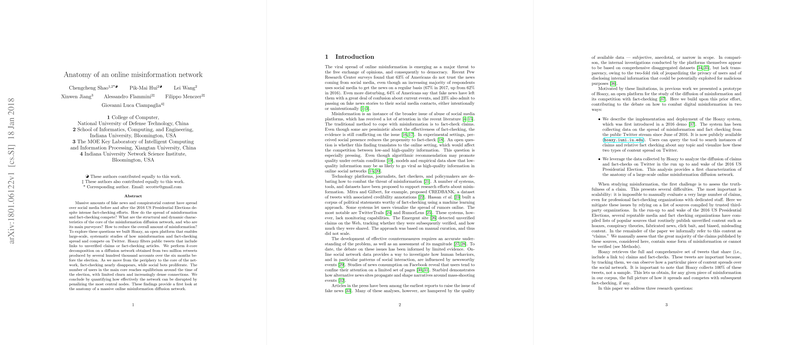Analysis of Misinformation Diffusion Networks
The paper "Anatomy of an online misinformation network" presents an investigation into the nature and dynamics of misinformation spread on social media, particularly focusing on Twitter during the 2016 US Presidential Elections. By developing and utilizing Hoaxy, a platform designed to paper misinformation and fact-checking dynamics, the authors offer insights into characteristics and behaviors within misinformation diffusion networks. This essay will summarize the key findings and implications of their research, with an eye toward understanding its impact on future studies in misinformation and social media networks.
The authors address three core research questions: the competition between misinformation and fact-checking, the structural features of misinformation networks, and strategies to reduce misinformation exposure. The paper covers significant ground by utilizing the Hoaxy platform to track and analyze a large corpus of misinformation and fact-checking instances. Notably, they perform -core decomposition on a network formed by millions of retweets, revealing structural dynamics and user roles in the diffusion process.
Core Findings
- Competition Between Misinformation and Fact-Checking: The paper illuminates a clear imbalance in the spread of misinformation relative to fact-checking. Evidently, only a small fraction (5.8%) of tweets pertain to fact-checking, compared to those spreading unverified information. Using -core decomposition, the researchers highlight the core-periphery structure of the network, where misinformation predominates deeper into the network, and fact-checking becomes almost absent in the core. Interestingly, instances where fact-checks persisted in the core were found to be either misused or used to discredit fact-checking bodies.
- Characteristics of Misinformation Networks: The paper provides detailed insights into the stability and robustness of these networks. They identify a dense and stable core of users, including both human-operated and automated (bot) accounts, suggesting deliberate and systematic propagation of misinformation. By tracking the main core over time, the paper shows how network density and the spread influence shift around major events like the Presidential Election, resulting in a persistent set of core users.
- Reduction Strategies: Perhaps the most intriguing aspect of the paper is the assessment of how misinformation spread can be attenuated by targeting key nodes within the network. Disconnecting a small number of influential accounts significantly curtails overall misinformation spread, highlighting a feasible strategy for social media platforms. The paper indicates that targeting users with high out-strength—those who are extensively retweeted—yields the most effective reduction in misinformation diffusion.
Implications and Future Directions
The research presented in this paper underscores the complexity and resilience of misinformation networks. It also raises pertinent questions concerning the strategies that platforms can adopt to counteract fake news and conspiratorial content. The fact that the most central nodes in the diffusion network correlate with specific political leanings indicates an intersection of misinformation with political agendas, which both academics and policymakers must consider.
For future research, extending the analysis to include multilingual and non-Western environments would be pivotal in understanding global misinformation dynamics. Additionally, expanding the Hoaxy platform's data sources and developing capabilities beyond Twitter could provide a more comprehensive view of misinformation spread across different social media ecosystems.
The methodologies and findings discussed in this paper will undoubtedly serve as a valuable resource for researchers aiming to further dissect the anatomy of misinformation networks, as well as for those designing interventions to mitigate misinformation influence in digital spaces. The quantifiable impact demonstrated, through strategically reducing misinformation spread by targeting network core nodes, also offers a promising direction for practical implementation on social media platforms.
